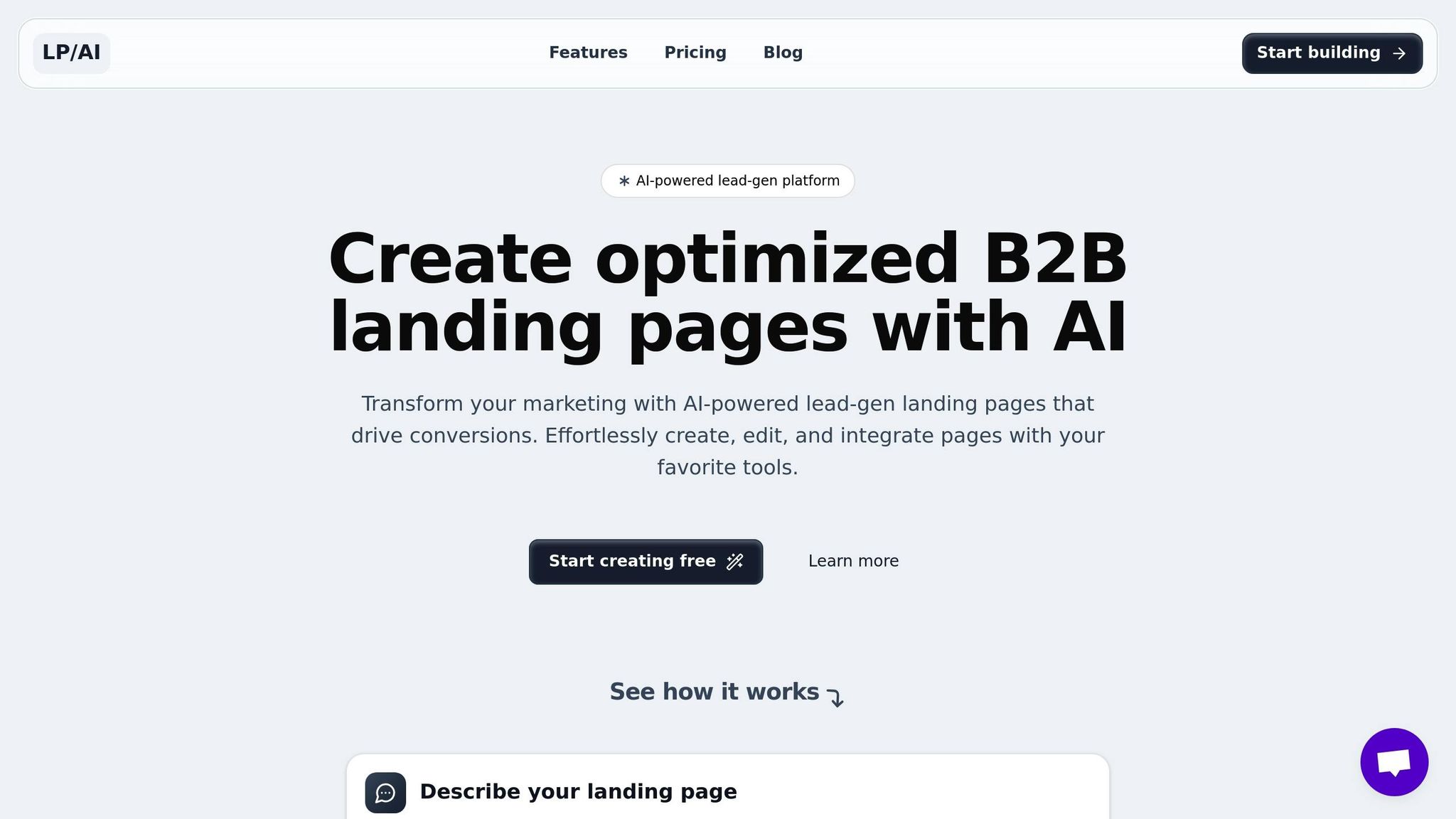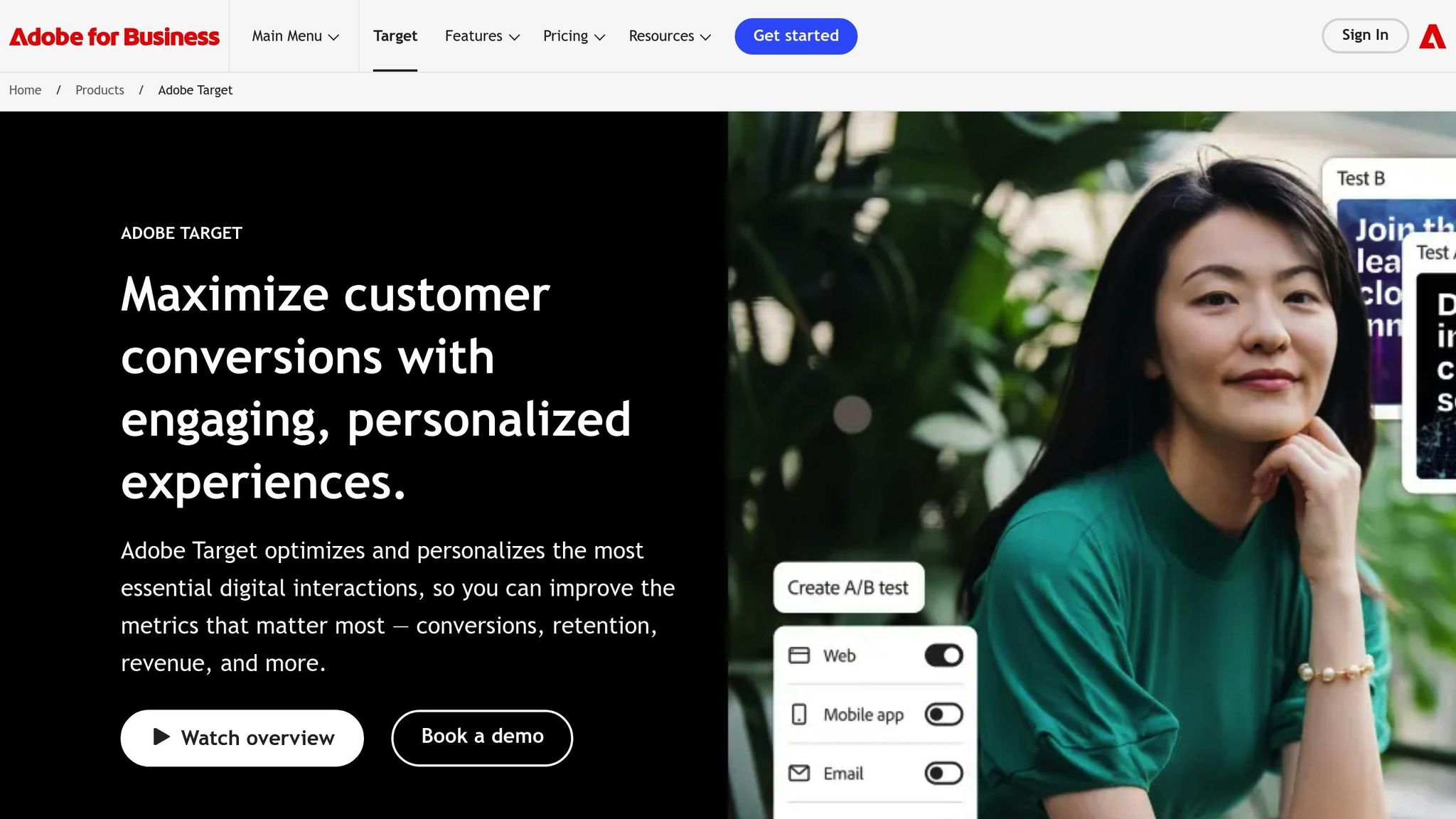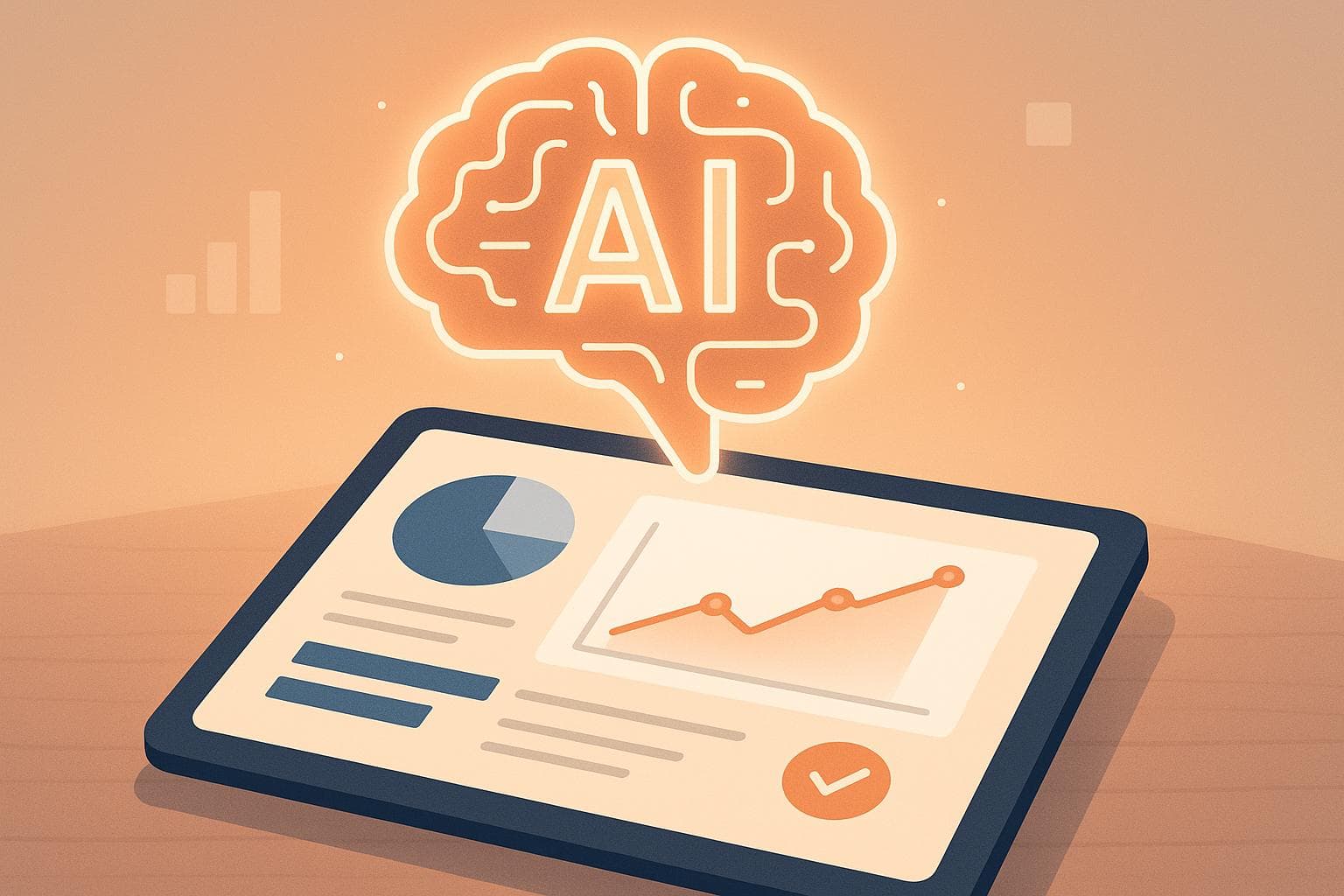AI in Dynamic Content Testing: How It Improves CRO
AI is transforming dynamic content testing by automating processes, predicting user behavior, and personalizing experiences in real-time. Traditional A/B testing often results in limited success, but AI-driven tools are achieving conversion rate increases of 20–25%. Platforms like AI Landing Pages and Adobe Target are leading the charge, each offering distinct benefits:
- AI Landing Pages: Best for small to medium-sized businesses, it simplifies landing page creation and testing with automated tools and integrations with platforms like HubSpot and Salesforce.
- Adobe Target: Designed for enterprises, it delivers advanced testing and deeper personalization through machine learning and integration with Adobe Experience Cloud.
Quick Comparison:
| Feature | AI Landing Pages | Adobe Target |
|---|---|---|
| Automation | Fast page generation, AI-driven tests | Machine learning for personalization |
| Personalization | Behavioral data for tailored content | Advanced algorithms for deeper insights |
| Integrations | HubSpot, Salesforce, Marketo | Full Adobe Experience Cloud suite |
| Testing Options | Multivariate, audience-based | Auto-Target, experience-level tests |
Choose AI Landing Pages for simplicity and speed, or Adobe Target for enterprise-level personalization and testing depth. Both platforms can significantly improve your conversion rates, so align your choice with your business size and needs.
1. AI Landing Pages

AI Landing Pages revolutionize the way businesses test and optimize their landing pages. By using machine learning, these platforms automate page creation and continuously refine content to boost conversions.
Automation Capabilities
Automation takes the hassle out of manual tasks like image optimization, content updates, and keyword placement, reducing both time and errors. This frees up marketing teams to focus on strategy rather than getting bogged down in technical details.
Instead of relying on traditional A/B testing setups, AI Landing Pages can generate and test multiple page variations in real time. This allows the platform to identify the most effective combinations while keeping each version engaging through dynamic adjustments.
The system also uses behavioral data to suggest improvements based on how visitors interact with the pages. This constant feedback loop ensures that landing pages evolve over time, leading to better performance. In fact, companies using AI-driven testing tools have reported conversion rate increases of up to 25%, with 71% seeing measurable improvements.
But automation is just the beginning - personalization takes these landing pages to the next level.
Personalization Depth
AI Landing Pages provide a highly tailored experience by aligning content with each visitor's intent and profile. This means that when someone clicks on an ad, the landing page they see is specifically customized to match their needs and search behavior.
The platform uses data like keywords, firmographics, and demographics to adjust messaging. For instance, a Fortune 500 executive might see entirely different content than a startup founder, even if both arrive through the same campaign. AI further enhances this experience by creating variations in headlines, body text, and calls-to-action based on visitor characteristics.
What sets this system apart is its ability to adapt in real time. By analyzing large datasets, it identifies patterns and anticipates what visitors need, offering insights that go far beyond static personalization.
To make the most of these personalized experiences, seamless integration with other marketing tools is critical.
Integration Options
AI Landing Pages work effortlessly with popular marketing platforms like Marketo, HubSpot, and Salesforce, eliminating the need for third-party connectors that can slow down data syncing.
These integrations enable real-time data sharing, ensuring that when a visitor converts, their information is automatically updated in CRM systems. This triggers follow-up actions without requiring manual input. Analytics tools like Google Analytics also receive detailed conversion data, while email marketing platforms can segment audiences based on landing page interactions. This interconnected setup ensures that insights from landing page performance feed directly into broader marketing strategies.
Test Types Supported
The platform supports a variety of testing methods that go beyond basic A/B comparisons. For example, it enables multivariate testing, allowing marketers to test multiple elements - like headlines, images, calls-to-action, and layouts - at the same time. This comprehensive approach uncovers winning combinations that might be missed with traditional testing methods.
Audience-based testing is another standout feature. It lets marketers create unique experiences for different visitor segments, such as enterprise buyers versus small business owners, while maintaining statistical accuracy across all variations.
Finally, continuous testing ensures that landing pages are always improving. The platform constantly analyzes performance metrics and applies updates, driving better results over time. These advanced testing capabilities reinforce the platform's ability to deliver higher conversion rates and more effective campaigns.
2. Adobe Target

Adobe Target brings enterprise-level AI capabilities to dynamic content testing. With its advanced machine learning tools, it’s designed to deliver tailored experiences at scale - making it a go-to solution for large organizations with complex testing demands.
Automation Capabilities
Adobe Target's Automated Personalization (AP) leverages a Random Forest algorithm to match offers with individual visitor profiles. This approach takes the guesswork out of personalization by analyzing visitor behavior and predicting the likelihood of conversion for each interaction. The system automatically updates its models every 24 hours, incorporating the latest visitor data to stay aligned with shifting trends - no manual adjustments needed. Marketers can also use Adobe's Visual Experience Composer (VEC) to create different offer variations, while the platform determines the best version to display. This constant model refinement ensures deeper, more accurate personalization.
Personalization Depth
Adobe Target uses real-time data and machine learning to deliver highly tailored experiences. It goes beyond simple demographic targeting, analyzing customer actions, preferences, and other data points to present the most relevant content, product options, and navigation paths. For example, a major clothing retailer implemented Adobe Target’s Auto-Target feature across ten product category-based experiences. This resulted in an average performance boost of 29.09% and generated over $1.7 million in extra revenue within just ten days. By personalizing 90% of experiences after model setup, the campaign demonstrated how quickly the AI can adapt and optimize. While many platforms focus on personalization, Adobe Target stands out with its real-time data integration and sophisticated algorithms.
Integration Options
Adobe Target integrates seamlessly with the Adobe Experience Cloud suite, including Adobe Analytics, Adobe Campaign, and Adobe Audience Manager. It also connects with Adobe Experience Manager (AEM) for content management and the Real-time Customer Data Platform for deeper audience insights. These integrations, managed through Adobe Launch, enable smooth data sharing and coordinated marketing efforts across multiple channels. Additionally, Adobe Target extends its testing capabilities beyond web pages, such as incorporating email marketing through Adobe Campaign. This unified ecosystem approach sets it apart from platforms with standalone integration models.
Test Types Supported
Adobe Target supports a variety of testing methods tailored to different optimization needs. Its Auto-Target activities are ideal for testing complete experiences rather than individual content elements, making them perfect for page-level changes. Unlike traditional multivariate testing, Auto-Target requires less traffic to build effective models. It dynamically selects the best experience for each visitor based on their profile and behavior, moving beyond static tests to deliver personalized, visitor-specific content. For instance, if a user searches for "world cup" and lands on a page, Adobe Target can dynamically insert that term into the content to align with their intent. By continuously optimizing for conversions through machine learning, the platform minimizes manual test management while delivering consistent performance improvements.
sbb-itb-6d52c2d
Platform Comparison: Advantages and Disadvantages
Choosing the right platform for dynamic content testing involves weighing the strengths and limitations of each option. Below is a table summarizing key features, followed by a detailed breakdown of what each platform brings to the table.
| Feature | AI Landing Pages | Adobe Target |
|---|---|---|
| Automation Capabilities | AI-driven content creation, design suggestions, and fast page generation | Machine learning for personalized experiences and automated traffic allocation |
| Personalization Depth | Behavioral analysis with dynamic content adaptation | Random Forest algorithm for advanced personalization |
| Integration Options | Connects easily with Marketo, HubSpot, and Salesforce | Full integration with Adobe Experience Cloud and enterprise-level data sharing |
| Test Types Supported | A/B testing with AI-optimized variations | Auto-Target activities, Automated Personalization, and experience-level testing |
AI Landing Pages: Speed and Simplicity
AI Landing Pages stands out for its efficiency and ease of use. With the ability to cut page creation time by up to 70%, it's an excellent choice for teams looking to launch campaigns quickly. Its chat-based editing and AI-powered content tools make professional landing pages accessible, even for users without technical expertise.
That said, the platform has limitations when it comes to large-scale testing. While it excels at generating optimized pages rapidly, it lacks the advanced behavioral analysis and complex testing options that larger enterprises often require. Organizations with intricate testing needs might find these limitations restrictive.
Adobe Target: Advanced Personalization and Testing Depth
Adobe Target shines in delivering tailored experiences through advanced testing and personalization. Its Automated Personalization feature uses machine learning to analyze visitor behavior and create highly customized experiences. For enterprises, Adobe Target’s seamless integration with the Adobe Experience Cloud ensures a unified data ecosystem, making it ideal for complex, cross-departmental workflows.
However, Adobe Target's complexity and resource demands can be a hurdle for smaller teams. The platform requires technical expertise to set up and manage, which may not be feasible for businesses with limited resources.
"Adobe Target optimizes and personalizes the most essential digital interactions, so you can improve the metrics that matter most - conversions, retention, revenue, and more." - Adobe
Integration and Cost Considerations
AI Landing Pages offers straightforward integrations with popular marketing tools like Marketo, HubSpot, and Salesforce, enabling streamlined workflows for smaller teams. On the other hand, Adobe Target’s enterprise-grade integrations support more complex data sharing across departments, making it a better fit for larger organizations with advanced needs.
Cost is another critical factor. AI Landing Pages typically provides more affordable pricing tiers, making it accessible for smaller businesses or teams looking to grow incrementally. In contrast, Adobe Target requires a significant upfront investment and ongoing management resources, aligning better with enterprise-level budgets.
Final Thoughts
Your choice between these platforms ultimately depends on the complexity of your testing needs and the size of your organization. If your goal is to create high-converting landing pages quickly with effective personalization, AI Landing Pages is likely the better fit. For businesses requiring deeper behavioral insights, complex testing scenarios, and robust data integrations, Adobe Target offers the advanced functionality to meet those demands. Carefully consider these factors to find the platform that aligns best with your dynamic content testing goals.
Final Recommendations
When it comes to dynamic content testing, selecting the right AI-driven platform can significantly impact your conversion rates. Research indicates that AI-optimized landing pages can achieve up to 32% higher conversion rates compared to traditional ones. This makes your platform choice a critical factor in driving marketing success. The size of your business and the technical resources at your disposal will largely determine the best fit for your needs.
For small to medium-sized businesses, AI Landing Pages stands out as an excellent option. Its intuitive interface, chat-based editing, and AI-powered content generation streamline the process, making it easier for smaller teams to adopt and execute effective testing strategies. Plus, its compatibility with tools like Marketo, HubSpot, and Salesforce ensures smooth integration into your existing marketing workflows.
On the other hand, larger enterprises often require more advanced solutions. For organizations with complex testing needs and dedicated technical teams, Adobe Target offers cutting-edge machine learning capabilities and deep integration with Adobe Experience Cloud. These features enable large-scale personalization, but the platform's complexity and resource demands may pose challenges for businesses lacking substantial technical expertise.
Industry data further underscores the benefits of AI-driven landing pages, with many companies reporting conversion improvements that align with or even surpass the 32% benchmark. These gains directly translate to increased revenue, making a strong case for adopting AI-powered tools.
Budget considerations also play a role. While AI Landing Pages provides scalable pricing tiers suitable for businesses of various sizes, Adobe Target is better suited to enterprise budgets due to its higher implementation costs and advanced capabilities.
"The future of paid advertising lies not in reaching more people, but in reaching exactly the right people with exactly the right message at exactly the right time. AI makes this level of precision possible." – Eric Siu, CEO of Single Grain
To mitigate risks, consider starting with a pilot project. Focus on high-impact, low-complexity areas and measure ROI rigorously. This approach allows you to evaluate the platform's effectiveness before committing to a full-scale rollout, giving you confidence in your AI-driven testing strategy.
Whether you're a small business looking for simplicity and speed with AI Landing Pages or an enterprise seeking advanced personalization with Adobe Target, the decision boils down to aligning the platform's capabilities with your current needs and future growth plans. Both options offer the tools to help you capitalize on the opportunities AI brings to modern marketing.
FAQs
How does AI Landing Pages improve dynamic content testing compared to traditional A/B testing?
AI Landing Pages revolutionizes how dynamic content is tested by using real-time, AI-powered experimentation. Unlike the old-school A/B testing approach, which relies on manually creating static variations and lengthy testing periods, AI Landing Pages adjusts and fine-tunes content continuously based on actual user behavior. This means quicker insights and improved conversion rates - without the hassle of constant manual tweaks.
By automating the entire testing process and delivering tailored experiences on a large scale, AI Landing Pages allows businesses to achieve better outcomes more efficiently, while also saving valuable time and resources.
What are the key benefits of using Adobe Target for enterprise-level personalization?
Adobe Target gives businesses the tools to craft highly personalized customer experiences by leveraging AI-powered automation and real-time data insights. It allows companies to conduct A/B and multivariate testing, fine-tune content across various channels, and create custom experiences that drive both engagement and conversions.
By using automation at scale and profile-based personalization, Adobe Target helps brands strengthen customer loyalty through relevant and consistent interactions across web, mobile, and other platforms. Plus, its smooth integration with other tools makes it a valuable asset for large-scale marketing strategies.
How does AI Landing Pages integrate smoothly with popular marketing tools like CRM systems?
AI Landing Pages make it easy to connect with top marketing tools, including CRM systems, through low-code integration platforms. Tools like Zapier and Workato simplify the process of linking AI Landing Pages to platforms such as HubSpot, Salesforce, and Marketo.
These integrations handle tasks like lead tracking, updating content, and personalizing campaigns automatically. The result? Businesses save time, simplify their workflows, and get more out of their marketing efforts.
